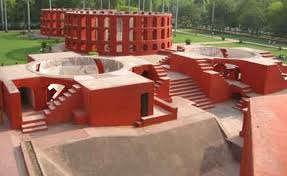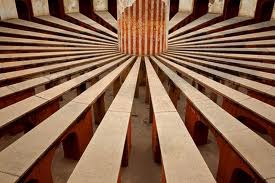Jantar Mantar
Book Now
Jantar Mantar in Delhi
 Jantar Mantar in Connaugth Place, New Delhi was built by Maharaja Jai Singh II, the ruler & founder of Jaipur, in India. This ancient monument (built in 1724) is one of the five astronomical observatories build by Maharaja Jai Singh II as he was given by Mughal emperor Muhammad Shah the task of revising the calendar and astronomical tables. Besides Jantar Mantar in New Delhi, the other four being located at Jaipur, Varanasi, Ujjain and Mathura. The main objective of making Jantar Mantar observatory was to compile astronomical tables, and to predict the times and movements of the sun, moon and planets. Jantar Mantar in Connaugth Place, New Delhi was built by Maharaja Jai Singh II, the ruler & founder of Jaipur, in India. This ancient monument (built in 1724) is one of the five astronomical observatories build by Maharaja Jai Singh II as he was given by Mughal emperor Muhammad Shah the task of revising the calendar and astronomical tables. Besides Jantar Mantar in New Delhi, the other four being located at Jaipur, Varanasi, Ujjain and Mathura. The main objective of making Jantar Mantar observatory was to compile astronomical tables, and to predict the times and movements of the sun, moon and planets.
History of Jantar Mantar
 All these observatories were made during the period of AD 1724-1730. That was the time when Mughal Empire was rapidly declining. During this period turmoil, Muhammad Shah ascended the throne of the Mughal Empire. But since there were number of enemies surrounded him, he south the alliance of many Hindu rulers, out of whom Sawai Jai Singh II of Amber was the most notable one. Sawaii Jai Singh was barely 11 years old when throne of Amber was ascended to him in 1699 but he handled the situation so well that Mughal emperor Aurangzeb gave him the title of 'Sawai', meaning one and a quarter of an average man in worth. As Muhammad Shah was seeking a reliable ally with Hindu ruler, Jai Singh proved to be a dependable ally of Mughals. He was also one of the noble in Mughal court. All these observatories were made during the period of AD 1724-1730. That was the time when Mughal Empire was rapidly declining. During this period turmoil, Muhammad Shah ascended the throne of the Mughal Empire. But since there were number of enemies surrounded him, he south the alliance of many Hindu rulers, out of whom Sawai Jai Singh II of Amber was the most notable one. Sawaii Jai Singh was barely 11 years old when throne of Amber was ascended to him in 1699 but he handled the situation so well that Mughal emperor Aurangzeb gave him the title of 'Sawai', meaning one and a quarter of an average man in worth. As Muhammad Shah was seeking a reliable ally with Hindu ruler, Jai Singh proved to be a dependable ally of Mughals. He was also one of the noble in Mughal court.
Jai Singh was a keen astronomer and passionate about art and science mainly astronomy. Once in the court he found Hindu and Muslim astronomer having a heated argument about certain astronomical fact to find out an auspicious hour for the emperor to set out on an expedition. Jai Singh then offered to rectify the then available astronomical tables. He was dissatisfied by the brass and metal astronomical instruments and decided to correct and update the astronomical records with more accurate instruments. The result was an onsite Jantar Mantar in Delhi, an astronomical observatory where the movements of sun, moon and planets could be observed.
Location of Jantar Mantar
This great masterpiece of Indian architecture is located at Parliament Street, Connaught Place. Jantar Mantar in Connaught Place is maintained by the Jaipur government because it was built by Maharaja Sawai Jai Singh II of Jaipur in 1710 A.D.
Architecture of Jantar Mantar
 Maharaja Jai Singh named this observatory in New Delhi as Yantra Mantra. As the time goes on this is being known as Jantar Mantar. There are four distinct instruments within the observatory of Jantar Mantar: the Samrat Yantra, the Ram Yantra, the Jayaprakasht, and the Mishra yantras. Maharaja Jai Singh named this observatory in New Delhi as Yantra Mantra. As the time goes on this is being known as Jantar Mantar. There are four distinct instruments within the observatory of Jantar Mantar: the Samrat Yantra, the Ram Yantra, the Jayaprakasht, and the Mishra yantras.
The Samrat Yantra 'Prince of Dials' is the largest device and used to measure the accurate time of the day. It also measured the declination of the sun which can be seen by the shadow moving around the structure. The Jai Prakash Yantra consists of hollowed out hemispheres with markings on their concave surfaces, shows the sun's position at the time of equinox. There is a hole near the bottom of the structure which witnesses sunshine only once in a year that is on 21 march, called vernal eqinox.
Another important structure called the Ram Yantra, consists of two large buildings with open top. Both these two buildings form a complete device. The device is used to measure the altitude of stars which is equivalent to the latitude and the longitude on the earth. The Mishra yantra were able to indicate when it was noon in various cities all over the world. It consists of five instruments. Pillars on the southwest of Mishra Yantra are used to measure the shortest day (21 December) and the longest day (21 June) of the year.
The whole structure of Jantar Mantar is made of stone and marble with each of then having an engraved astronomical scale. Jantar Mantar finally got the status of a national monument in 1948. As compared to other observatories this one is the largest and the best preserved today. Jantar Mantar Observatory in Connught Place, New Delhi is an integral part of India’s scientific heritage. The Jantar Mantar in Delhi is often projected in travel books, brochures, on postage stamps and was the logo of the 1982 Asian Games. It has always attracted architects, historians and scientists from all over the world. Jantar mantar remains one of the most intriguing structures of Indian capital, one that explodes in a burst of questions in the mind of the inquisitive tourist.
More Info
Timings: Time to visit Jantar Mantar is daily between 9.00am - 7.00pm.
How to reach: Since Jantar Mantar observatory is located in Connaught place the central location, there are many ways that tourists can reach here. Auto-rickshaws and local taxis are available from all major points while taxis and cabs available on request. One can take local buses from various points or from two Inter State Bus Terminals located at Kashmere Gate and Anand Vihar. Now a day Delhi Metro Train is also one of the better options to reach Rajiv Chowk Metro Station and from there Jantar Mantar is a walking distance. Local guided tours conducted by Delhi Tourism and private operator’s covers this important monument.
|